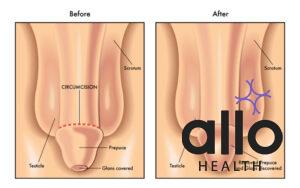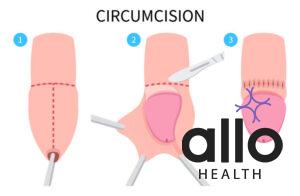Understanding the Benefits and Risks of Circumcision

Allo Health is dedicated to personalized well-being, offering support and trusted information tailored to individual health goals. The platform emphasizes human-generated content, led by a distinguished medical team of experts, including physicians and sexual health specialists. Their commitment to credibility involves rigorous fact-checking, authoritative research, and continuous updates to ensure accurate, up-to-date information. Allo Health's unique approach goes beyond conventional platforms, providing expert-led insights and a continuous commitment to excellence, with user feedback playing a crucial role in shaping the platform's authoritative voice.

Dr.Joshua has completed his MBBS from Father Muller Medical College,Mangalore.He has been a mental health advocate since the last 6 years and the cofounder of Talkaloud,an NGO dealing with mental health issues in youths and teenagers.He has keen interest in sexual health and has contributed widely in bringing awareness to the general public on the topic.
Why This Was Upated?
Our experts continually monitor the health and wellness space, and we update our articles when new information became available.
Updated on 18 March, 2024
- Article was updated as part of our commitment to diversity, equity, and inclusion.

"The following blog article provides general information and insights on various topics. However, it is important to note that the information presented is not intended as professional advice in any specific field or area. The content of this blog is for general educational and informational purposes only.
Book consultation
The content should not be interpreted as endorsement, recommendation, or guarantee of any product, service, or information mentioned. Readers are solely responsible for the decisions and actions they take based on the information provided in this blog. It is essential to exercise individual judgment, critical thinking, and personal responsibility when applying or implementing any information or suggestions discussed in the blog."
Circumcision is a surgical procedure that involves the removal of the foreskin from the penis. The procedure has been practised for thousands of years, and it continues to be a popular choice for many men and parents of newborn boys. However, there are also many debates surrounding the potential benefits and risks of circumcision. In this article, we will explore the different aspects of circumcision and help you make an informed decision about whether circumcision is the right choice for you or your child.
What Is Circumcision?

Circumcision is a surgical procedure that removes the foreskin, the fold of skin covering the head of the penis. Some medical reasons for circumcision are Phimosis (a condition where the tight foreskin cannot be retracted or pulled back), paraphimosis (a condition where the foreskin can no longer be pulled forward over the tip of the penis), recurrent balanitis, urinary tract infections, preventing penile cancer, and sexually transmitted infections. Circumcision is performed for religious, personal, or preventive health reasons.
Circumcision practice has historical and cultural significance and is performed for religious and cultural reasons. Individuals’ reasons for circumcision may differ. Circumcision is a cultural practice for many Islamic families. In the United States of America, newborn circumcision is done for babies before they leave the hospital. In some parts of the world, circumcision is done for older boys or men to reduce the risk of certain sexually transmitted infections.
Circumcision is an important part of many religious and cultural traditions, including Judaism, Islam, and certain African communities. For many, circumcision is seen as a rite of passage or a way to show commitment to the faith. It is important to respect these cultural traditions and understand the reasons why circumcision is such an important practice for many people.
Why Is Circumcision Performed?
Good Hygiene:
Circumcision promotes good hygiene by simplifying the process of cleaning the penis. It is important to keep the penis clean. With the foreskin removed, there is less accumulation of sweat, urine, and debris, reducing the risk of bacterial growth and hygiene-related issues. Regular cleaning is still important, regardless of circumcision status, to maintain proper genital hygiene.
Preventing Penile Problems:
- Phimosis: Phimosis is a condition where the foreskin of the penis is too tight and cannot be pulled back or retracted over the glans (head of the penis). In severe cases, phimosis can lead to difficulty urinating, discomfort, and an increased risk of infections. Circumcision helps to cure phimosis by removing the foreskin entirely, which eliminates the tightness and allows for easier hygiene and improved urinary function.
- Recurrent Balanitis: Balanitis is inflammation of the glans (head) of the penis. Some individuals can experience frequent or recurrent balanitis, which can be painful and uncomfortable. The condition most commonly occurs in an uncircumcised penis. In such cases, circumcision may be recommended to reduce the risk of future infections and alleviate symptoms. The foreskin traps bacteria, debris, and moisture that creates an environment conducive to inflammation. Circumcision helps to cure recurrent balanitis by removing the foreskin of the penis.
- Paraphimosis: In paraphimosis, the foreskin cannot be pulled back over the glans to its original position. This condition causes painful swelling and potential tissue damage. Circumcision is done to remove the foreskin surgically and it permanently exposes the glans. By removing the tight foreskin, circumcision effectively prevents the reoccurrence of this condition.
Reduces the risk of Urinary Tract Infections (UTIs): Circumcision can potentially reduce the risk of urinary tract infections (UTIs) in male infants. The mechanism behind this risk reduction is related to the removal of the foreskin during circumcision. Other factors, such as hygiene practices and underlying medical conditions, can also play a role in the development of UTIs.
Prevention of Penile Cancer: Though penile cancer is rare, circumcision is done to reduce the risk of developing this type of cancer. Penile cancer can be caused by many other factors such as sexually transmitted infections and smoking.
Reduces the risk of Sexually Transmitted Infections (STIs): Circumcision is linked to reduced risk of acquiring certain sexually transmitted infections (STIs) including HIV, herpes, and human papillomavirus (HPV). However, using condoms and following safe sexual practices is crucial in preventing sexually transmitted infections.
What Can You Expect During Circumcision?

During Circumcision Procedure:
- Pre-Procedure Preparation: Before the circumcision, the doctor will explain the procedure and obtain informed consent. If you or your child is preparing for a circumcision procedure, there are several steps you can take to make the experience as comfortable as possible. Some tips include managing pain with medication, staying hydrated, and avoiding certain foods and drinks before the procedure.
- Anesthesia Administration: Depending on the type of circumcision, the patient will receive either general anesthesia (complete unconsciousness) or local anesthesia (numbing of the surgical area). Local anesthesia is commonly used for adult and older child circumcisions, while general anesthesia is more typical for infant circumcisions.
- Incision and Removal: Once the anesthesia takes effect, the surgeon will perform the circumcision. Using the chosen technique (e.g., conventional, Plastibell, Gomco clamp, Mogen clamp, or Shang Ring), the foreskin will be carefully removed, and any bleeding vessels will be cauterized or stitched.
- Wound Care and Dressing: The surgical site will be dressed in sterile gauze or bandages to protect it during the initial healing process.
After Circumcision Procedure:
It takes seven to eleven days to heal.
- Recovery Room Stay: After the circumcision, the patient may spend some time in the recovery room to be monitored for any immediate postoperative issues. The patient may experience pain and can notice a small amount of yellow fluid on the penis tip.
- Rest and Healing: Resting is essential during the initial recovery period. The patient should avoid strenuous activities and keep the area clean and dry to aid healing. Some tips for recovery and aftercare include avoiding strenuous activity, applying ice or heat as needed, and keeping the area clean and dry. It is also important to follow any specific instructions provided by your healthcare provider regarding aftercare.
- Swelling and Bruising: The penis tip may look sore at first and later looks swollen or bruised. Swelling and bruising around the surgical site are common and should subside gradually over the next few days. It is completely fine to wash the penis. In newborn babies, apply petroleum jelly on the penis tip to prevent it from sticking to the diaper.
- Healing Time: The complete healing process may take several weeks. During this time, the patient should follow any specific care instructions provided by the healthcare provider.
- Complications: While complications are rare, potential risks include bleeding, infection, and issues related to anesthesia. Any signs of infection, excessive bleeding, or unusual symptoms should be reported to the healthcare provider promptly.In addition to the above tips, it is important to avoid sexual activity for at least 4-6 weeks after the procedure to allow for proper healing. It is also common to experience some swelling, bruising, and discomfort in the area for the first few days after the procedure. Over-the-counter pain medication can be taken as directed by your healthcare provider to help manage any discomfort.If you notice any signs of infection, such as redness, swelling, or discharge from the area, it is important to contact your healthcare provider immediately. They may prescribe antibiotics or recommend additional treatment to prevent the infection from spreading.
Another important aspect of preparing for a circumcision procedure is to ensure that you have a support system in place. This can include family members, friends, or a healthcare professional who can provide emotional support and help you through the process. It is also important to take time off work or school to allow for proper rest and recovery after the procedure.
Different Types of Circumcision Techniques and Procedures
There are various methods of circumcision, including the use of a scalpel or a circumcision clamp.
Conventional or “Sleeve” Technique: The conventional method is a widely practiced surgical technique. Using a surgical scalpel, the surgeon makes incisions around the foreskin to separate it from the glans. The excess foreskin is then removed, and the remaining edges are sutured together. This technique is known for its effectiveness and has been performed for generations.
Plastibell Method: One of the most common circumcision techniques is the Plastibell method, which involves placing a small plastic ring around the foreskin and cutting off the excess skin. This method is often preferred for newborns and infants because it is quick and relatively painless. However, it may not be suitable for older children or adults.
Gomco Clamp Technique: Another technique is the Gomco clamp method, which involves using a special clamp to compress the foreskin and remove the excess tissue. This method is often used for older children and adults, as it allows for more precise control over the amount of tissue removed. However, it may be more painful and require a longer recovery time than other methods.
Mogen Clamp Technique: Similar to the Gomco clamp technique, the Mogen clamp method employs a flat, concave clamp. The surgeon positions the clamp to secure the foreskin before removing the excess tissue. The Mogen clamp is known for its efficiency and is often used for neonatal circumcisions.
Shang Ring Technique: The Shang Ring technique is a relatively modern approach to circumcision. It involves placing a plastic or metal ring around the foreskin to compress and stabilize it. A specialized device is used to cut off the excess foreskin beyond the ring’s edge. The Shang Ring remains in place for a short period until the wound heals, after which it is removed. This method is less invasive and gaining popularity in certain regions.
One area of research that is gaining attention is the use of topical anesthesia during circumcision. This method involves applying a numbing cream or gel to the penis before the procedure, which can help reduce pain and discomfort. Studies have shown that topical anesthesia can be effective in reducing pain during circumcision, and may be a viable option for those who are concerned about the pain associated with the procedure.
What Are the Benefits of Circumcision?
The benefits of circumcision include:
- Improved genital hygiene
- preventions of penile conditions such as phimosis, paraphimosis and balanitis.
- Decreases the risk of sexually transmitted infections
- Reduced the risk of penile cancer
- Prevents urinary tract infections (UTIs)
- For those who prefer a circumcised appearance or have cultural or religious beliefs that prioritize circumcision, the procedure can provide a sense of identity or adherence to tradition.
What Are the Risks of Circumcision?
Like any medical procedure, circumcision can come with certain risks and complications. Some of the possible risks include bleeding, infection, and scarring.
Surgical Complications: In rare cases, surgical complications may occur, such as excessive tissue removal, skin bridges, or scarring. These issues may necessitate further medical intervention.
Infection: Like any surgical procedure, circumcision carries a risk of infection at the surgical site. However, proper hygiene and postoperative care can significantly reduce this risk.
Bleeding: Some individuals may experience bleeding after the circumcision, especially within the first 24 hours. While most cases are minor and resolve on their own, excessive bleeding may require medical attention.
Delayed Healing: In some cases, the circumcision wound may take longer to heal than expected. Factors such as infection or poor wound care can contribute to delayed healing.
Risk of Circumcision Revision: In cases where the initial circumcision result is unsatisfactory or complications arise, revision surgery may be necessary.
However, the overall risk of complications is relatively low, and most men are able to recover from the procedure with minimal discomfort.
Debunking Common Myths About Circumcision
There are many myths and misconceptions about circumcision, and it is important to separate fact from fiction when considering this procedure. Some of the common myths include-
#Myth: Circumcision reduces sexual pleasure.
Fact: Circumcision enhances sexual stimulation
The sensory receptors in the penis are unaffected by circumcision. No significant evidence supports the claim that circumcision reduces sexual pleasure for men. Studies on sexual function and satisfaction have shown no consistent differences between circumcised and uncircumcised individuals.
#Myth: Circumcision is only performed for religious reasons.
Fact: Circumcision is also performed for medical reasons
While circumcision is an essential religious practice in some cultures and religions, it is also performed for medical reasons and personal preferences. Some individuals and parents choose circumcision based on its potential health benefits.
#Myth: Circumcision is a cosmetic procedure
Fact: Circumcision is not a cosmetic procedure
Circumcision is not considered a cosmetic procedure in the traditional sense. While some individuals and parents may choose circumcision for aesthetic reasons, such as cultural or personal preferences, its primary purpose is not solely for cosmetic enhancement.
Relationship Between Circumcision and Sexual Function
There is still much debate about the relationship between circumcision and sexual function. Some studies have suggested that circumcision may have a positive impact on sexual pleasure and function, while others have found no significant difference between circumcised and uncircumcised males. Ultimately, the decision to undergo circumcision for sexual reasons is a personal one, and it is important to discuss your concerns and expectations with your healthcare provider.
The Debate Over Infant vs Adult Circumcision
Circumcision can be performed in both adulthood and infancy. For adults, it requires informed consent and is often done for medical reasons, cultural or religious beliefs, or as a personal choice. Medical indications may include treating conditions like phimosis or recurrent balanitis. In infants, circumcision is usually based on the parents’ cultural, religious, or medical considerations. It is commonly performed for cultural or religious practices and is associated with potential health benefits, such as reduced risks of UTIs and certain STIs. Infant circumcision is generally considered safer, with a quicker recovery period. Ultimately, the decision for circumcision should be based on individual circumstances and informed discussions with healthcare professionals.
Alternatives to Traditional Circumcision: Pros and Cons
Some of these alternatives include partial circumcision, topical creams, and foreskin restoration techniques.
Partial Circumcision: It involves removing only a portion of the foreskin, rather than the entire foreskin. This can be a good option for those who want to maintain some of the protective and sensory benefits of the foreskin, while still addressing any medical concerns.
Topical Creams: Topical creams, such as steroid creams, can also be used to treat certain conditions that may otherwise require circumcision. Foreskin restoration techniques involve stretching the remaining foreskin tissue to create a more natural appearance and restore some of the lost sensitivity.
While these alternatives may have their benefits, it is important to note that they may not be as effective as traditional circumcision in treating certain medical conditions. It is important to discuss all options with your healthcare provider to make an informed decision.
Conclusion
In conclusion, circumcision is a complex issue with many potential benefits than risks. By understanding these factors and considering your own personal beliefs and circumstances, you can make an informed decision about whether circumcision is the right choice for you or your child. It is important to discuss your concerns and questions with your healthcare provider to ensure that you receive the best possible care and support throughout the process.
Frequently Asked Questions-
Q. Is Circumcision Beneficial or Harmful?
Circumcision has both potential benefits and risks. Some medical benefits include a reduced risk of urinary tract infections in male infants. It also lowers the risk of certain sexually transmitted infections. It treats specific medical conditions like phimosis and balanitis. The risks include surgical complications, bleeding, infection, and the possibility of pain and discomfort during recovery. The decision to undergo circumcision should be based on individual preferences, cultural beliefs, and medical considerations.
Q. What Are the Disadvantages of Circumcision?
Circumcision carries risks of bleeding, infection, and adverse reactions to anesthesia. The procedure can cause pain and discomfort during and after the surgery, especially during healing.
Q. What Happens If You Don’t Circumcise Your Body?
If you choose not to undergo circumcision, your body will remain intact, and the foreskin covering the head of the penis will be retained. This natural covering serves a protective role, keeping the glans sensitive and moisturized. However, it’s essential to maintain good genital hygiene by regularly cleaning the area to prevent potential issues like infections.
Q. Can I Get Circumcised at the Age of 40?
Yes, it is possible to get circumcised at the age of 40. Adult circumcision is a common procedure for various reasons, such as medical conditions, religious beliefs, or personal preferences.






































